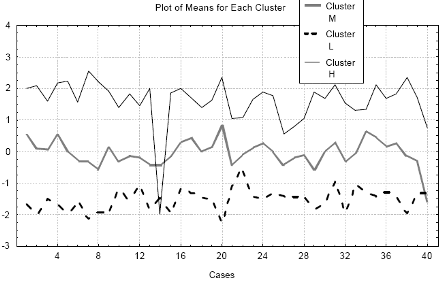Factor 1 can be interpreted as:
The growth of foreign and domestic investments in the Polish stock market. Reliability results for the 10 highest loadings (absolute values) of items belonging to the factor:
Cronbach’s Alpha =0,93
Factor 2:
The withdrawal of foreign and domestic investments from stock market. Reliability results for the 10 highest loadings (absolute values) of items belonging to the factor:
Cronbach’s alpha =0.75
Factor 3:
Unfavorable macroeconomic and political signals. Reliability results for the 5 highest loadings (absolute values) of items belonging to the factor:
Cronbach’s alpha =0.57
Factor 4
Positive financial and macroeconomic signals. Reliability results for the 5 highest loadings (absolute values) of items belonging to the factor:
Cronbach’s alpha =0.79
Actually two groups of factors can be derived. Factors 1 and 2 constitute the first group. Factors 3 and 4 – the second group. Each group represents one “mind construction”. The factors inside each group have effects in opposite directions. It can be concluded that factors are not based on the nature of the items. Economic, political and technical analysis signals go together, especially in factor 1 and 2. High Cronbach’s alpha coefficient indicates reliability of the factor structure.
Which questionnaire items were perceived as highly influencing market movements?
In order to examine which of the 56 items received highest, lowest and medium marks, indicating respondents’ opinions on their power to affect stock prices, a cluster analysis was carried out. The cluster analysis was conducted in two stages. A horizontal hierarchical tree plot and a graph of amalgamation schedule (Ward’s method amalgamation rule, Euclidean distances) indicated 3 main clusters. K-means clustering (constant intervals) divided all 56 items into 3 clusters.

Fig. 1 The plot of the means for each of 3 clusters. Cases represent the questionnaire participants.
Cluster L consists of 31 items – including unfavorable economic, financial and political situation in Poland, negative technical signals. Cluster M consists of 7 items (Drop in oil prices, Rise in coal prices, Street demonstrations, Big stock emissions, Post-communist and socialist forces win parliamentary election, WIG breaks its main rising trend line, a rise in the total numbers of orders on a bullish market) which according to participants opinion have small or none impact on future stock prices. Cluster H consists of 18 items – including favorable economic, financial and political news accompanied by the technical signals of bull market.
The participants marked 49 items as strongly affecting future stock prices (positively: cluster H; negatively: cluster L) regardless if their nature was economic, political or “technical”. The questionnaire participants opinion is that a great majority of items demonstrate rather strong impact on the future market movements, which is not conformable with the results of the analytical research (Cutler, 1989), (Fama, 1981), showing that only a small part of stock return variation can be explained by publicly known news.
Prof. Piotr Zielonka
Next: Inter-judge agreement
Summary: Index